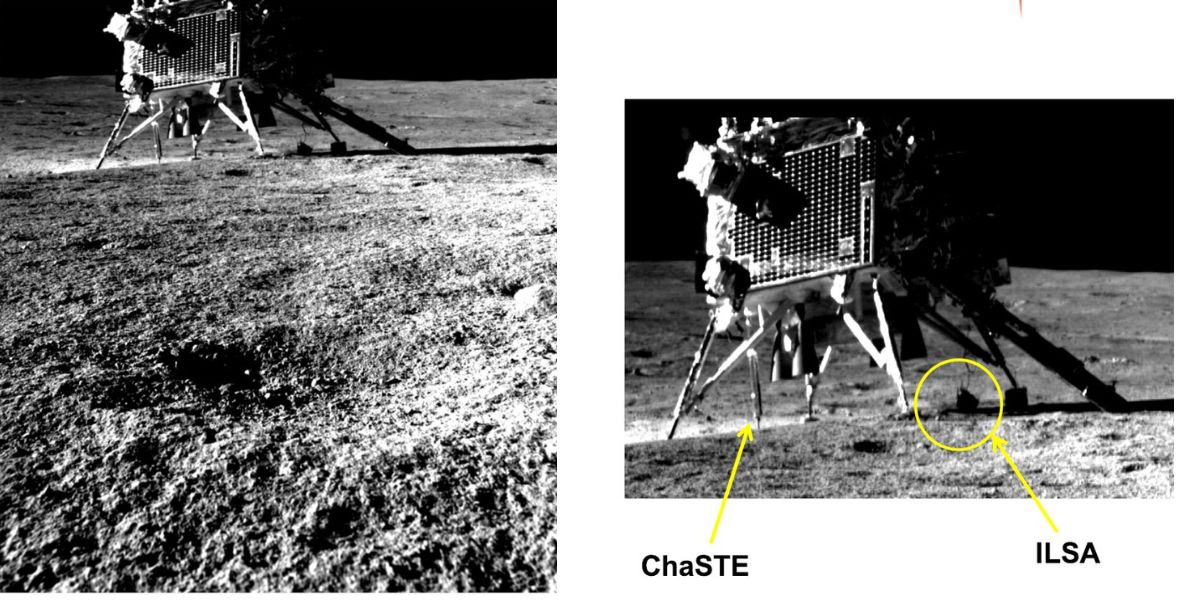On Tuesday, the Pragyan rover unambiguously confirmed the presence of sulphur on the lunar surface near the south pole.
Published Aug 30, 2023 | 2:00 PM ⚊ Updated Aug 30, 2023 | 2:00 PM

The images of Vikram lander taken by Pragyan rover. (X/ISRO)
The Pragyan rover, which is conducting surface tests on the moon after its dissociation from the Vikram lander following its soft landing on the Moon, sent back the images of the Vikram lander on Wednesday, 30 August.
“Smile, please! Pragyan Rover clicked an image of Vikram Lander this morning. The ‘image of the mission’ was taken by the Navigation Camera onboard the Rover (NavCam),” said the Indian Space Research Organisation (ISRO) in a post on X (formerly Twitter).
“NavCams for the Chandrayaan-3 Mission are developed by the Laboratory for Electro-Optics Systems (LEOS),” it added.
Chandrayaan-3 Mission:
Smile, please📸!
Pragyan Rover clicked an image of Vikram Lander this morning.
The 'image of the mission' was taken by the Navigation Camera onboard the Rover (NavCam).
NavCams for the Chandrayaan-3 Mission are developed by the Laboratory for… pic.twitter.com/Oece2bi6zE
— ISRO (@isro) August 30, 2023
On Tuesday, the Laser-Induced Breakdown Spectroscope (LIBS) instrument onboard the Pragyan rover unambiguously confirmed the presence of sulphur on the lunar surface near the south pole, through first-ever in-situ measurements.
On 25 August, ISRO said that all planned Pragyan movements have been successfully executed.
It added that rover payloads LIBS and APXS have been turned “on”. “All payloads on the propulsion module, lander module, and rover are performing nominally.”
LIBS instrument uses laser beams to analyse the elemental composition of the lunar soil and rocks around the landing site.
By studying the elements present in these samples, scientists can gather information about the moon’s geology and composition.
The rover’s mission is expected to last for approximately one lunar day, which is equivalent to about 14 Earth days.
Chandrayaan-3 Mission:
In-situ scientific experiments continue …..
Laser-Induced Breakdown Spectroscope (LIBS) instrument onboard the Rover unambiguously confirms the presence of Sulphur (S) in the lunar surface near the south pole, through first-ever in-situ measurements.… pic.twitter.com/vDQmByWcSL
— ISRO (@isro) August 29, 2023
ISRO said on Tuesday the instrument also detected aluminium, calcium, iron, chromium, titanium, manganese, silicon and oxygen, as expected.
The space agency, in a statement, said, “The LIBS instrument onboard Chandrayaan-3 Rover has made the first-ever in-situ measurements on the elemental composition of the lunar surface near the south pole.”
“These in-situ measurements confirm the presence of Sulphur (S) in the region unambiguously, something that was not feasible by the instruments onboard the orbiters,” it added.
Chandrayaan-3 Mission:
Of the 3⃣ mission objectives,
🔸Demonstration of a Safe and Soft Landing on the Lunar Surface is accomplished☑️
🔸Demonstration of Rover roving on the moon is accomplished☑️
🔸Conducting in-situ scientific experiments is underway. All payloads are…
— ISRO (@isro) August 26, 2023
The presence of sulphur on the Moon holds importance for lunar science. It could suggest past or ongoing volcanic activity, shedding light on the Moon’s geological history. The connection between sulphur and other volatile compounds, like water, may be significant for future lunar exploration and resource utilisation.
Moreover, the presence of sulphur could provide insights into the Moon’s formation, evolution, and its potential to host certain extremophilic life forms. Comparing sulphur’s role on the Moon with other celestial bodies advances our understanding of planetary processes.
According to ISRO, LIBS is a scientific technique that analyses the composition of materials by exposing them to intense laser pulses.
It further added, “A high-energy laser pulse is focused onto the surface of a material, such as a rock or soil. The laser pulse generates an extremely hot, and localised plasma.”
“The collected plasma light is spectrally resolved and detected by detectors such as Charge Coupled Devices. Since each element emits a characteristic set of wavelengths of light when it’s in a plasma state, the elemental composition of the material is determined,” it said.
Preliminary analyses have unveiled the presence of Aluminum (Al), Sulphur (S), Calcium (Ca), Iron (Fe), Chromium (Cr), and Titanium (Ti) on the lunar surface. Further measurements have revealed the presence of manganese (Mn), silicon (Si), and oxygen (O), it said.
“Thorough investigation regarding the presence of Hydrogen is underway,” ISRO said.
LIBS instrument was developed at the Laboratory for Electro-Optics Systems at Peenya Industrial Estate, Bengaluru where the first India satellite was fabricated in 1975.
Chandrayaan-3 Mission:
All planned Rover movements have been verified. The Rover has successfully traversed a distance of about 8 meters.
Rover payloads LIBS and APXS are turned ON.
All payloads on the propulsion module, lander module, and rover are performing nominally.…
— ISRO (@isro) August 25, 2023
India on 23 August scripted history as ISRO’s ambitious third Moon mission Chandrayaan-3’s Lander touched down on the lunar surface, making it only the fourth country to accomplish the feat, and the first to reach the uncharted south pole of Earth’s only natural satellite.
Prime Minister Narendra Modi on 26 August announced the decision to name the spot where the Chandrayaan-3 Vikram lander made a soft landing as “Shiv Shakti Point” and the site where the Chandrayaan-2 lander crash-landed on the Moon’s surface in 2019 would be known as “Tiranga Point”.
Also, 23 August, the day the Chandrayaan-3 lander touched down on the lunar surface, would be celebrated as “National Space Day”, Modi had said.
This achievement made India the fourth country in the world — following the erstwhile Soviet Union, the US, and China — to successfully achieve a gentle landing on the Moon and also the first to make a successful landing at the south pole of the Moon.
(With PTI inputs)
